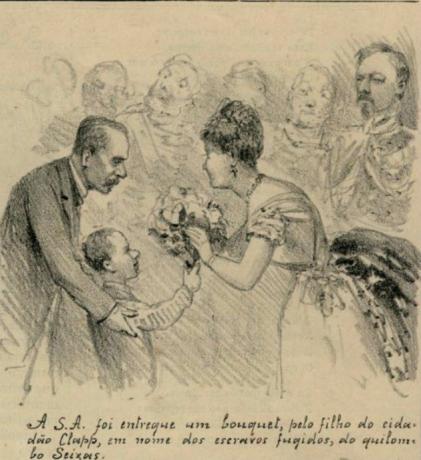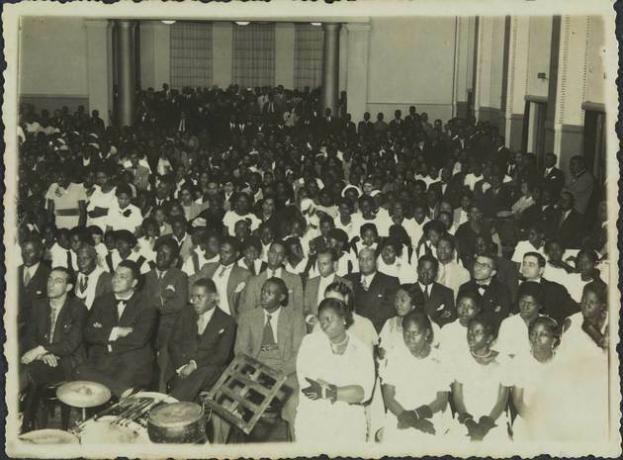O black movement it is a phenomenon used in the form of different organizations to claim rights for the black population that suffers from racism in society.
In most countries where blacks were enslaved, there was always an attempt to change the situation to which they were subjected.
Currently, the black movement is plural and brings together, in addition to agendas such as the fight against racism, different aspects such as feminism, the fight for LGBT rights and religious tolerance.
The black movement in Brazil has its roots in the very resistance to slavery that manifested itself through flight, hunger strikes and rebellions.
The Black Movement in the Colonial Period
To escape forced labor, enslaved blacks fled and organized themselves into quilombos. There they lived free in communities that could house from a few families to hundreds of people.
The most emblematic Quilombo during the colonial period was the Quilombo dos Palmares. There, a large number of escaped slaves were concentrated, who resisted for a long time the Portuguese military incursions. It was led for a few years by
Zumbi dos Palmares that would become a symbol for the black movement.Likewise, the captives gathered in brotherhoods such as Nossa Senhora do Rosário or São Benedito, to help each other in case of illness and ensure a dignified burial.
We can highlight the Sociedade dos Desvalidos de Salvador, which functioned as a space for coexistence and assistance for blacks.
In addition to the Catholic religion, it is necessary to take into account that the candomblé it never stopped being practiced by blacks. Thus, participating in the ceremonies, often carried out clandestinely, was a way of resisting the cultural changes brought about by slavery.
The Black Movement in the Empire

During the 19th century, with the growth of the abolitionist movement, black intellectuals started to edit newspapers and found cultural associations with the objective of claiming the end of slavery.
Writers such as José do Patrocínio, Luís da Gama and the abolitionist societies are organizing to demand the end of slave labor in the country.
In addition, there continued to be escapes, rebellions and associations of freedmen who pooled money to buy the freedom of those who remained enslaved.
One of the quilombos that stands out at this time will be Seixas, which will go down in history as Quilombo do Leblon. This united a significant number of slaves who cultivated and traded with the local inhabitants. One of their identity passwords was camellias, which quickly became a symbol of abolitionism.
There were also slaves who obtained their freedom in court by proving that they had arrived in Brazil after the law or that they were born after the law of the free womb. In short, the second reign was rich in black resistance movements against slavery.
THE abolition of slavery in Brazil it comes gradually and without compensation for slave owners. Nor was there any financial compensation for the freed or social inclusion.
The Black Movement in the First Republic
During the First Republic, with the growth of cities, blacks gathered in cultural associations in order to maintain their traditions.
It must be remembered that these were always regulated and were closely watched by the police. After all, it was necessary to maintain the "order" that the Republic proclaimed and blacks were the element that presented the most danger to provoke "disorder".
A clear example of this is the mandatory registration of Candomblé terreiros and houses. Even so, the ceremonies could be disrupted and violently dispersed by the police.
The press, on the other hand, will constitute a privileged place for the Brazilian black movement. We can mention the group of black intellectuals unite to found the newspaper "the dawn", in 1907, in the city of Pelotas (RS).
In São Paulo, several periodicals appeared that dealt with recreational clubs and unions for blacks. Newspapers like "The Dawn Bugle" (1924-1932) or "Progress" (1928-1931) were important for the visibility of the Brazilian black population.
It will be art, however, that will have the greatest adhesion of black people as a way to preserve their identity, while absorbing other influences. This is the case of the emergence of choro, the first Brazilian musical genre, and of ranchos and associations around samba.
In 1926, the Companhia Negra de Revista appeared in Rio de Janeiro, comprising names such as Pixinguinha, Grande Otelo, Donga and many others. Made up entirely of black artists, the Company was a landmark in the dramatic arts of Brazil.
The Black Movement in the Vargas Era
However, the first exclusively political organization emerged with the Frente Negra Brasileira (FNB). Founded on September 16, 1931, in São Paulo, its objective was to denounce the racism of society.
edited the newspaper "The Voice of the Race" and became a political party in 1936. However, with the coup of 37, carried out by Getúlio Vargas, it was extinguished like all the political parties of the period.

Despite the brief experience, it must be noted that blacks were involved in political movements on both the left and the right.
In the field of arts, we cannot forget to mention the Black Experimental Theater, founded by Abdias Nascimento, in 1944, whose exponent was the actress Ruth Souza.
The Black Movement in the 50s
Likewise, the history of black people becomes an object of academic study through the works of Florestan Fernandes, which makes contributions to the understanding of racism in Brazil.
It is important to remember the Afonso Arinos Law enacted in 1951. For the first time, race or color discrimination became a misdemeanor.
Although the law only covers crimes committed in public spaces, the Afonso Arinos Law came to show the hidden racism of Brazilian society.
The Black Movement in the 60s
At this time, the Brazilian black movement was influenced by the Civil Rights struggle in the United States. We have iconic figures like the Reverend Martin Luther King, which defends the inclusion of black people through peaceful resistance.
The motto "Black is Beautiful" valued the black aesthetic over the white model. In this way, black men and women stop straightening their hair, dress with African motifs and start to enhance their phenotype instead of hiding it.
All of this will influence fashion and the perception that black Brazilians had of themselves as well.
On the other hand, leaders such as Malcon X and the "Black Panthers" movement proposed the use of violence as a means to achieve greater participation in American society.
The Black Movement in the 70s
The 70s will be marked by increased repression of leftist political groups and intense political propaganda around the economic miracle.
In Rio de Janeiro, discussions on racial issues begin at the Center for Afro-Asian Studies, linked to the Cândido Mendes University.
Important groups will leave from there, such as SINBA (Brazil-Africa Exchange Society), IPCN (Institute for Research of Black Cultures) and MNU (Unified Black Movement).
Discussions were marked by the ideological polarity of the time. Thus, the debates were divided between the American references of the black movement and those who defended a rapprochement with Africa and its colonial liberation struggle.
In 1978, these organizations will leave the discussions restricted to their members to take to the streets. Thus, on July 7, the Black Movement Against Racial Discrimination appears on the steps of the Municipal Theater of São Paulo.
This movement was a milestone for black organizations in Brazil, as it brought them together around a single agenda.
Defying the dictatorship, blacks exposed racial and social prejudice on the streets, wage differentials, and also specific demands of women such as sexism.
Although many ruptures were registered among its members, the Unified Black Movement would carry out important demonstrations in favor of racial equality.
Through its mobilization it would manage to transform several demands into laws such as the mandatory teaching of African History and the criminalization of racial discrimination.
The Black Movement in the 80s

In order to promote the history and memory of black people, the Ipeafro (Institute for Afro-Brazilian Research and Studies), in 1981, by Abdias Nascimento.
The Institute's mission is to value and disseminate African and black history in Brazilian schools, producing material and supports for teachers and students.
With the return of democracy and the discussion of a new Constitution for the country, the black movement gains strength. The government is also interested in promoting studies, institutes and laws that promote racial equality or at least reduce the gap between whites and blacks.
In this sense, in São Paulo, the state government created, in 1984, the first Black Community Participation Council (CPDCN), by governor Franco Montoro.
The federal government instituted the Palmares Cultural Foundation in 1988, a very significant year, as the first centenary of the Golden Law.
On the initiative of the Unified Black Movement, in 1986, during the National Conference of Blacks in Brasília – DF, the proposal to make racial and ethnic prejudice a crime was implemented. Likewise, the land titling of remnants of Quilombos was requested.
In 1989, Law 7,716/1989 was enacted, on the initiative of deputy Alberto Caó, whose racial and ethnic discrimination becomes a crime. In 1997 and 2012, this law would be revised, also incorporating religious or national intolerance as a crime.
See too: racial democracy.
The Black Movement in FHC's government
President Fernando Henrique Cardoso instituted the Interministerial Working Group for the Valorization of the Black Population, on November 20, 1995.
This initiative was based on alarming data from IBGE and IPEA, regarding the profound socio-economic inequality between blacks and whites.
To commemorate this fact, on the same day, representatives of various entities of the black movement promoted the Marcha Zumbi, in Brasília, which was attended by 30,000 people.
The Black Movement in the Lula government
The period in which President Lula occupied the presidency was marked by several achievements of civil society in general and of the black movement in particular.
In 2003, the Special Secretariat for the Promotion of Racial Equality (SEPIR) was created, whose mission was to promote social inclusion mechanisms for the black population.
One of the banners of the black movement was the approval of racial quotas in federal educational institutions that was already being applied in some states.
The "Lei das Quotas" was approved in 2006 and since then the increase of blacks and browns in federal universities has been visible.
The Black Movement in the 21st Century
In addition to the enshrinement, at the federal level, of the Quota Laws, the black movement has never been so plural. Based on the issue of combating racism, other discussions were opened, such as prejudice against black women, black homosexuals, black trans, etc.
Likewise, new discussions arise such as the "cultural appropriation", the "whitening" and the Christianization of Afro-Brazilian traditions such as the capoeira and the acarajé, which make the black movements remain alert to their demands.
Another important discussion is the genocide of the black population, especially young people, who are the constant target of police raids.
New leaders and intellectuals have emerged as a result of the Quota Law. Among them, we can mention Djamila Ribeiro, Núbia Moreira and Rio councilor Marielle Franco (PSOL/RJ), brutally murdered because of her political struggles in March 2018.
Likewise, as in every democracy, there are blacks who do not align themselves with these postures. This is the case of São Paulo councilor Fernando Holliday (DEM/SP) who wishes to revoke the Black conscience day.
Read more:
- African culture
- Malês revolt
- Main Characteristics of Afro-Brazilian Culture
- Women who made the history of Brazil
- Extraordinary Women Who Made History
- congada
- Origin of Black Consciousness Day
- Poems to reflect on Black Consciousness



